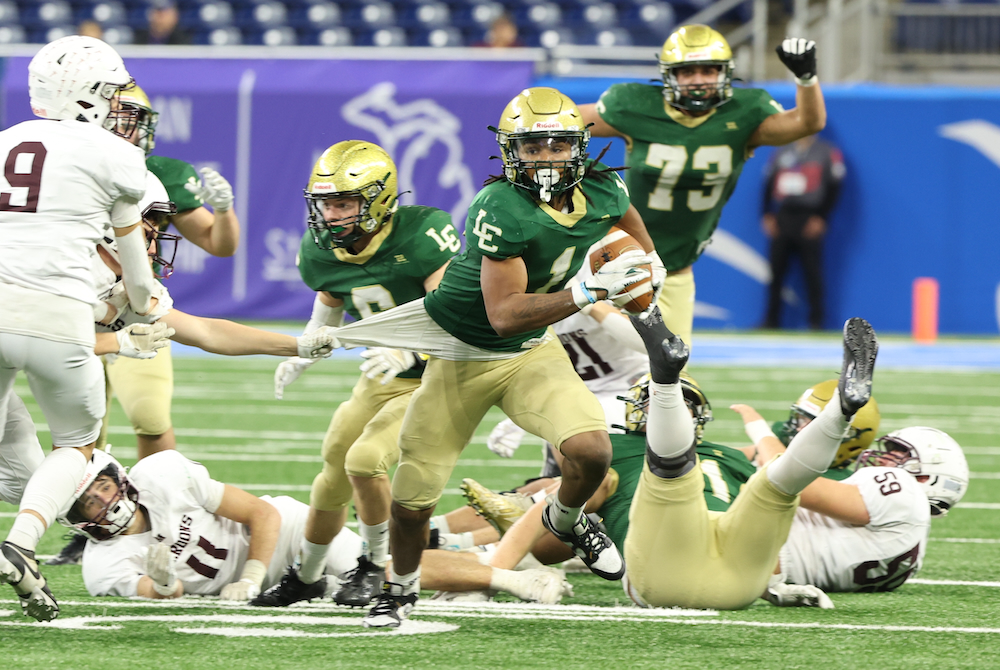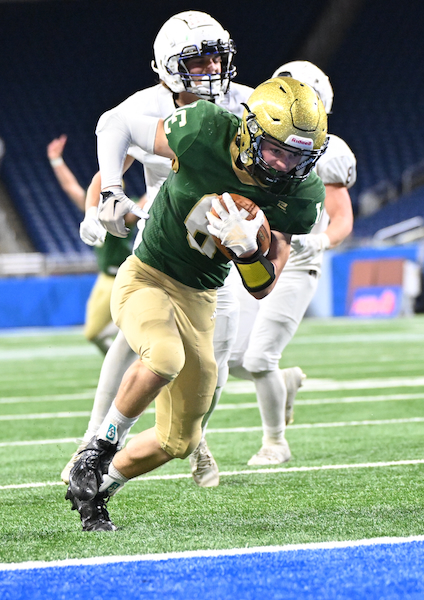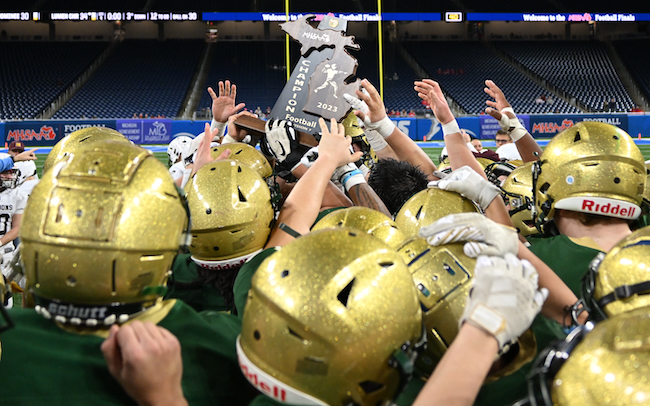
Haslett Saving Big Hits for Game Time
August 16, 2016
By Geoff Kimmerly
Second Half editor
HASLETT – The sound of cleats on pavement. He and his teammates, hand in hand, walking toward the field together minutes before kickoff. Manowar’s “Heart of Steel” ringing in their ears from a few minutes before.
 Justin Kuchnicki gave himself goose bumps Monday describing Haslett’s weekly pregame ritual, which the senior lineman will take part in again beginning Aug. 26 when the Vikings open this season against Remus Chippewa Hills.
Justin Kuchnicki gave himself goose bumps Monday describing Haslett’s weekly pregame ritual, which the senior lineman will take part in again beginning Aug. 26 when the Vikings open this season against Remus Chippewa Hills.
They’ll certainly be revved up – and especially to lay some big hits after saving them up during three weeks of non-collision practices.
Haslett has one of the most successful football programs in the Lansing area, with two trips to MHSAA championship games and 14 playoff appearances total over the last 18 seasons. The Vikings finished 6-4 a year ago against a schedule featuring four eventual playoff teams.
The program also might be the first in all of Michigan high school football to fully eliminate full-speed hitting at practice, something Haslett has moved toward over the last few seasons before longtime coach Charlie Otlewski decided to knock it out of his practice plans completely this fall in large part to keep his players healthier for when it matters most.
“It gives you the edge when it gets to game day. You practice all week and you’re not really hitting or doing anything like that, and you get to game day … and everyone’s ready to just go out there and fly around and make plays,” Kuchnicki said. “You’re not really worried about kinks and stuff in your body that you’d have from practices, so you just go out there and lay it on the line.”
Friday was the first day Michigan high school players were allowed to practice in full pads. Storms drenched mid-Michigan that afternoon, so Haslett’s first day in full gear was Monday. And from a distance, it sounded like any other full-contact practice with the normal hoots and hollers and smacking of pads.
But on closer look, it was anything but. Lineman worked against blocking dummies on a sled or teammates holding hand pads. When the offense came together to run plays, linemen blocked against overturned plastic trash barrels. On the opposite end of the field, subvarsity players worked on defensive pursuit angles but again without hitting. Under a set of uprights laid an old gymnastics mat used to soften the fall during tackling drills, which players again did against standup dummies instead of their teammates.
Reducing collisions – that is, live, game-speed, player-vs.-player hitting – remains the focus of most conversations on health and safety in football. Much of the discussion is centered on reducing concussions, and MHSAA rules changes that took effect beginning with the 2014 season limit teams to one practice per day during the preseason (when teams frequently practice twice) where collisions can take place. During the regular season, teams can have collisions during practice only two days per week.
 Otlewski – who formerly coached St. Ignace from 1990-93 before taking over at Haslett in 1994 – said his practices used to follow what could be considered a traditional after-school plan: individual position drills for an hour or more followed by 11-on-11 full contact team practice for 30-40 minutes, twice a week.
Otlewski – who formerly coached St. Ignace from 1990-93 before taking over at Haslett in 1994 – said his practices used to follow what could be considered a traditional after-school plan: individual position drills for an hour or more followed by 11-on-11 full contact team practice for 30-40 minutes, twice a week.
But a handful of reasons, chiefly the desire to avoid injuries, started his program on a different path five years ago.
“Nobody wants injuries, but you surely don’t want them in practice. Then the concussion thing started to happen. (But) we didn’t do it because of concussions; we did it because of general overall injuries,” Otlewski said.
“If we lose a guy in Thursday’s scrimmage, or next Thursday in a game, OK, that’s football. But what we don’t want to do is lose someone in practice, because that seems unnecessary.”
The initial changes Haslett began to make to practices that fall of 2011 became drastic two years later, when he and his staff went to a different practice model completely. The Vikings now break every practice into 10-minute sessions alternating between team time and position drills, so position coaches can work with players individually before and after seeing how they perform when all 11 are running plays together.
This new breakdown brought the amount of player-on-player contact at practice down significantly as much more time was dedicated to learning proper footwork, blocking and tackling techniques and other fundamentals. Players on Monday worked at 50-percent speed, at most, against teammates either in front of them and also not moving at game speed, or against others holding pads and dummies.
The last two seasons, the only full-contact session during practices came during preparation for goalline situations; Otlewski and his staff decided to eliminate those this fall as well.
“We’re OK with a certain level (of contact). But we never want to go on the ground; we always want to stay up,” he said. “We want to go fast enough so where we have to use the perfect technique to get there footwork-wise. But we’re trying to eliminate the physicality part.”
To be clear, eliminating all collisions/contact is not required by the MHSAA. And there are probably more than a few in the coaching fraternity who would think Haslett is making a massive mistake.
But the Vikings’ no-contact strategy follows a way of thinking made popular in part by coaches like Dartmouth College’s Buddy Teevens, whose team hasn’t tackled during practices in six years. The Ivy League as a whole adopted a policy of no tackling in practice for the regular season beginning this fall.
 Otlewski said teaching to tackle without contact allows his players to practice the same technique-building drills during four-player offseason workouts, his team’s no-pads summer camp and then while wearing pads during the season. His defense doesn’t face a live offense during the week, but he doesn’t think his players lose out because they can gain just as much from watching film and working on pursuit angles and recognizing formations. Same goes for his offense, which can still practice skill work and the passing game full-speed while lineman go half-speed working on footwork and blocking technique.
Otlewski said teaching to tackle without contact allows his players to practice the same technique-building drills during four-player offseason workouts, his team’s no-pads summer camp and then while wearing pads during the season. His defense doesn’t face a live offense during the week, but he doesn’t think his players lose out because they can gain just as much from watching film and working on pursuit angles and recognizing formations. Same goes for his offense, which can still practice skill work and the passing game full-speed while lineman go half-speed working on footwork and blocking technique.
And he sees 37 players on his varsity roster, with that total remaining consistent over the last many seasons – while three opponents on this year’s schedule don’t have junior varsities and a fourth won’t field a freshman team.
His players three seasons ago didn’t really like the idea of not hitting in practice at first. But they’ve since bought in. He hasn’t heard a ton from parents either way; but he taught a class on football for local moms over the winter, and they seemed to like the idea as well.
“On one hand, I’m a little apprehensive,” Otlewski said. “OK, we haven’t gone full go. Is there a difference all of a sudden when it’s live Thursday against (Grand Rapids) Christian? Are we going to be up to speed?
“I think I still worry about that a little bit. But once we get into it, it’s fine.”
Kuchnicki is just as confident. Contact doesn’t bother this guy. He’s 6-foot-6 and in the neighborhood of 320 pounds. Sure, he’d love to have one contact practice this year so he and his teammates can back up some of the trash-talking they do to each other on the field.
But he’s fine with saving his biggest hits for opponents – and especially those who might think Haslett won’t be prepared for a physical game.
“They’d probably think we’re soft,” Kuchnicki said. “But when it comes game day, they change their minds instantly. I’ll tell you that.”
 Geoff Kimmerly joined the MHSAA as its Media & Content Coordinator in Sept. 2011 after 12 years as Prep Sports Editor of the Lansing State Journal. He has served as Editor of Second Half since its creation in Jan. 2012. Contact him at [email protected] with story ideas for the Barry, Eaton, Ingham, Livingston, Ionia, Clinton, Shiawassee, Gratiot, Isabella, Clare and Montcalm counties.
Geoff Kimmerly joined the MHSAA as its Media & Content Coordinator in Sept. 2011 after 12 years as Prep Sports Editor of the Lansing State Journal. He has served as Editor of Second Half since its creation in Jan. 2012. Contact him at [email protected] with story ideas for the Barry, Eaton, Ingham, Livingston, Ionia, Clinton, Shiawassee, Gratiot, Isabella, Clare and Montcalm counties.
PHOTOS: (Top) Haslett lineman work on blocking during Monday's practice. (Middle) Vikings coach Charlie Otlewski instructs his players on one of the team's blocking schemes. (Below) Backs work on the option with barrels serving as the defensive front.

Lumen Christi Answers Early Deficit, Scores Game-Winner Late to Earn Record-Tying Title
By
Tom Kendra
Special for MHSAA.com
November 26, 2023
DETROIT - Jackson Lumen Christi piled up 92 percent of its total yards Sunday morning on the ground.
So, trailing by three points with time running down in the fourth quarter and facing a 4th-and-4 situation on the Menominee 11-yard line, the Titans, of course, went to the air.
“It was a play we put in this week, and we (practiced) it over and over,” explained Lumen Christi junior quarterback Timmy Crowley. “Actually, it goes back to the summer and the connection that I developed with Gabe (King).”
Crowley delivered a strike to King on the sideline near the goal line, and King then spun into the end zone for the game-winning score with 4:04 remaining in an eventual 34-30 victory over upset-minded Menominee in a Division 7 title game shootout at Ford Field.
Menominee (11-3) had one final chance, driving into Lumen Christi territory, before senior quarterback Trevor Theuerkauf was hauled down from behind by freshman Lundon Hampton on fourth down to seal the win.
“It was an entertaining game, for sure,” said 44th-year Lumen Christi coach Herb Brogan, who was frustrated by some of his team’s blown coverages. “I like the way that we answered, time and time again.”
 Lumen Christi (13-1) won its second consecutive Division 7 title, its fifth championship over the past eight years and 13th overall – 11th under Brogan – moving the program into a tie with Farmington Hills Harrison for the most football titles in MHSAA history.
Lumen Christi (13-1) won its second consecutive Division 7 title, its fifth championship over the past eight years and 13th overall – 11th under Brogan – moving the program into a tie with Farmington Hills Harrison for the most football titles in MHSAA history.
It didn’t look good early for the Titans, as the Maroons used a 2-yard run by Landan Barkowski and a 34-yard pass from Theuerkauf to tight end Eli Beal to take a stunning 14-0 lead by the end of the first quarter.
The Titans settled down in the second quarter and fought back behind the speed, power and tackle-breaking ability of junior running back Kadale Williams (6-foot-1, 180 pounds), who finished with 27 carries for 276 yards and three touchdowns.
“It starts with the guys up front,” explained Williams, who rarely went down without multiple Maroons clutching onto him. “Once they do their jobs and create a gap, I owe it to them to make a play every time.”
Williams broke loose on TD runs of 1 and 45 yards during the second quarter, making the score 14-14 at halftime.
That set the stage for a classic back-and-forth second half, with both teams refusing to lose.
Menominee, a perennial power for years behind its tightly-packed, single-wing offense, showed off its offensive evolution under second-year coach Chad Brandt, who has incorporated elements of the spread. The Maroons kept the Titans guessing with a balanced attack, passing for 199 yards and rushing for 143.
“We were able to run and throw to keep them off balance, which is what we have been doing all year,” said Brandt, who was head coach at Stephenson in the Upper Peninsula for 20 years before coming to Menominee as an assistant coach in 2018. “We saw the predictions, but our kids are resilient. We were able to display our skills and just came up one play short.”
Lumen Christi stuck almost exclusively to the ground, with 351 rushing yards and 29 passing yards, scoring in the third quarter on a 1-yard run by Crowley and then early in the fourth quarter on a 3-yard run by Williams.
Each time the Titans took the lead in the second half and appeared poised to take control, the Maroons struck back, first on a 21-yard scoring scramble by Theuerkauf and then a 76-yard pass from Theuerkauf to Isaiah Odom, which gave them a 30-27 lead in the fourth quarter.
Then came the game-winning drive, as the Titans went 61 yards in 10 plays, culminating with the game-winning, 11-yard pass from Crowley to King.
Menominee was surely keying on Williams by that point in the game, which set up the winning play-action pass.
“I think we wear people down up front,” said Brogan, who took over the Lumen Christi program in 1980 after the death of Jim Crowley, who guided the Titans to their first two titles in 1977 and 1979. “When you do that and create seams, Kadale is going to make plays.”
 The Titans started four juniors up front in guards Andrew Salazar and Maverick Stergakos, center Drew Sweeney and tight end Charlie Saunders. The only senior starters on the offensive line were tackles Aiden Pastoriza and Luke Smith.
The Titans started four juniors up front in guards Andrew Salazar and Maverick Stergakos, center Drew Sweeney and tight end Charlie Saunders. The only senior starters on the offensive line were tackles Aiden Pastoriza and Luke Smith.
Both teams performed admirably on the big Ford Field stage, with just six total penalties and no turnovers.
Theuerkauf (5-11, 175) was all over the field during his final prep game, starting at his safety spot with a game-high 17 tackles (10 solos). He completed 9-of-22 passes for 199 yards and rushed 15 times for 84 yards.
Eli Beal made four catches for 63 yards and Tanner Theuerkauf, Trevor’s sophomore brother, had two catches for 42 yards. Blake Paasch made six tackles, and Beal and Tanner Theuerkauf each had five stops.
Both Crowley and Williams return next season for Lumen Christi, and their goal is to break the record for Finals wins.
“It’s so much fun handing the ball off to (Williams) and watching him run,” said Crowley, who finished 2-of-6 passing for 29 yards. “It means a lot with our tradition to win it, but I want to get back here next year and do it again.”
Isaac Rehberg carried seven times for 49 yards for Lumen Christi, while Josh Dumont and Ryan Walicki led the defense with eight tackles apiece.
PHOTOS (Top) Kadale Williams (1) pulls aways from a defender during Jackson Lumen Christi’s Division 7 win Sunday morning. (Middle) The Titans’ Gabe King leans into his fourth-quarter score. (Below) Lumen Christi raises its latest championship trophy at Ford Field. (Photos by Hockey Weekly Action Photos.)

